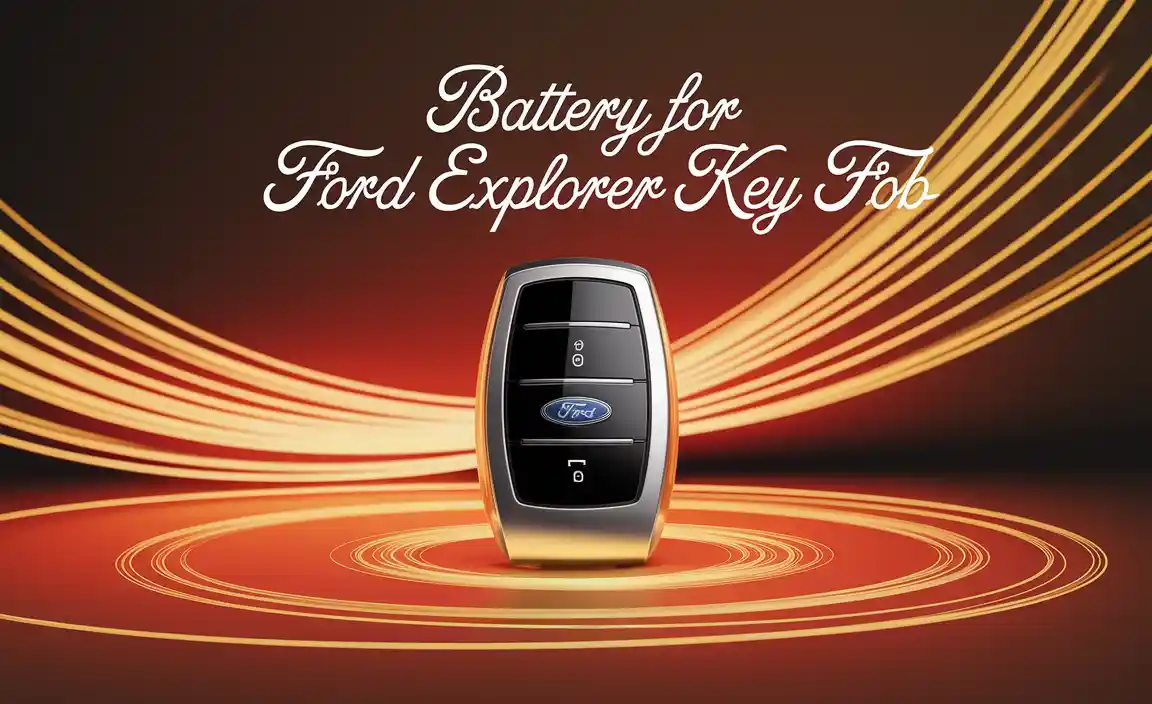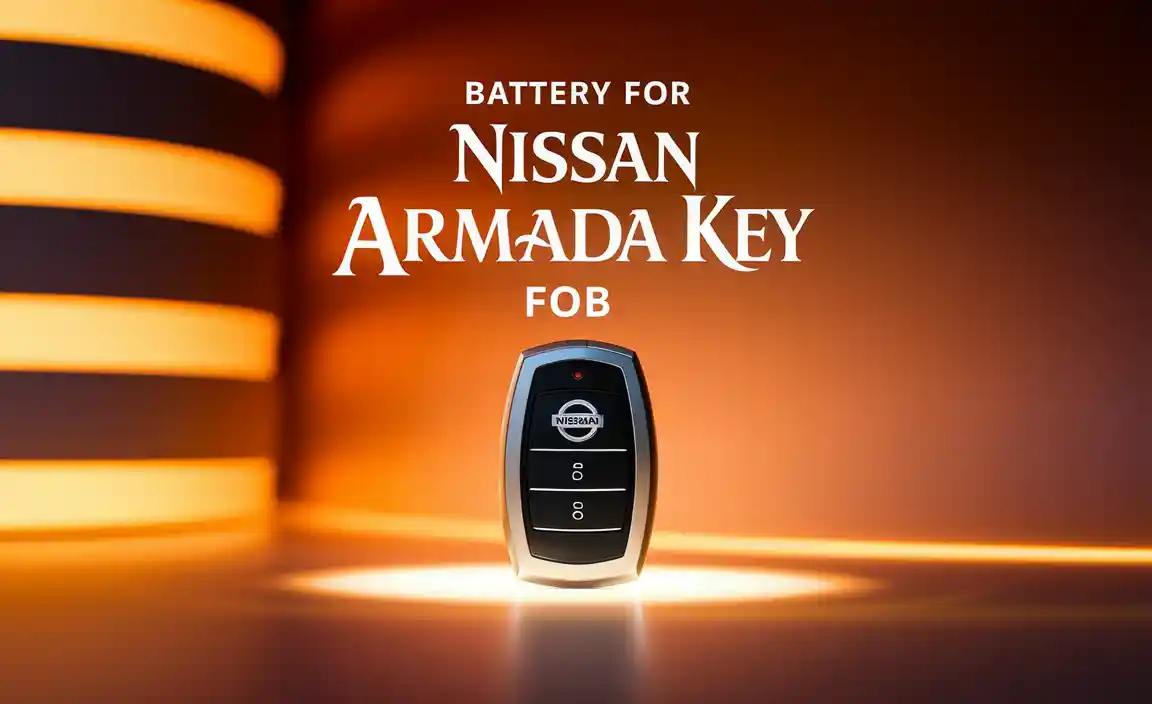When your Toyota Corolla’s stop-start system needs a new battery, opting for a cheap, quality replacement is essential for smooth operation and avoiding costly repairs. Look for an AGM battery specifically designed for vehicles with start-stop technology to ensure reliability and longevity. A well-chosen, affordable battery will keep your Corolla running efficiently without breaking the bank, offering peace of mind on every drive.
Is your Toyota Corolla’s start-stop system acting up? Do you notice the engine taking a little too long to restart after it automatically shuts off at a stoplight? Or perhaps you’re just looking to be proactive and keep your car running smoothly. For many Corolla owners, dealing with the battery is a common maintenance task. It can seem a bit confusing with all the different types of batteries out there, but don’t worry! We’re here to make it simple. This guide will walk you through choosing a great stop-start battery for your Toyota Corolla without spending a fortune. You’ll learn what makes a battery suitable for these modern systems and how to find affordable options that still deliver excellent performance. Let’s get your Corolla’s power system back in top shape!
Understanding Stop-Start Batteries for Your Toyota Corolla
Modern cars, like many Toyota Corollas, are increasingly equipped with stop-start technology. This clever system automatically shuts off the engine when you’re stopped – think at traffic lights or in bumper-to-bumper traffic – and then quickly restarts it when you’re ready to move. The main goal is to save fuel and reduce emissions. But this constant stopping and starting puts a lot more strain on the car’s battery than a traditional engine.
Because of this demanding job, standard car batteries often aren’t up to the task. They can wear out much faster and might not provide enough power for the frequent restarts. This is where specialized stop-start batteries come in. They are built tougher to handle the extra workload.
Why Standard Batteries Don’t Cut It
Imagine a regular battery as a marathon runner who occasionally sprints. A stop-start battery, on the other hand, is like a sprinter who has to sprint over and over again. The demands are different:
- Frequent Deep Discharges: The stop-start system draws power from the battery to run accessories like the radio, air conditioning, and lights while the engine is off. This is like the battery having to do mini-marathons.
- High Power Demands: When it’s time to restart the engine, the battery needs to deliver a powerful surge of electricity very quickly. This is the tough sprint.
- Durability: A standard battery isn’t designed to be discharged and recharged this frequently. It can lead to premature failure and leave you stranded.
The Rise of AGM Technology
For stop-start systems, the go-to technology is typically Absorbed Glass Mat (AGM). You’ll often see these recommended for cars with this feature. Why AGM? Let’s break it down in simple terms:
- Better Performance: AGM batteries are built to handle the deep cycling and high power demands required by stop-start systems with much more efficiency than older battery types.
- Increased Durability: They are designed to last longer under these stressful conditions, meaning fewer battery replacements over the life of your car.
- Vibration Resistance: The way AGM batteries are constructed makes them more resistant to vibrations, which is beneficial for any vehicle.
- No Spills: The electrolyte (the liquid that stores energy) is absorbed into special mats, making them spill-proof and maintenance-free. This is a big plus for safety and convenience.
While AGM batteries might have a slightly higher upfront cost than traditional flooded lead-acid batteries, their superior performance, lifespan, and suitability for stop-start technology make them a truly essential buy for your Toyota Corolla.
Identifying the Right Cheap Stop-Start Battery for Your Toyota Corolla
Finding a “cheap” battery doesn’t mean settling for low quality. It means finding the best value for your money. For your Toyota Corolla’s stop-start system, the key is to look for an AGM battery that meets the specific requirements of your vehicle. Here’s how to do it:
Key Features to Look For:
- AGM Type: As discussed, this is non-negotiable for stop-start systems. Don’t compromise here.
- Group Size: Your Corolla has a specific battery size designed to fit perfectly in its tray. This is usually indicated by a “Group Size” number (e.g., Group 24F, Group 35). Check your owner’s manual or look at your current battery.
- Cold Cranking Amps (CCA): This measures the battery’s ability to start an engine in cold weather. Your Corolla’s manual will specify the minimum CCA needed. Higher CCA is generally better, especially if you live in a cold climate.
- Reserve Capacity (RC): This tells you how long the battery can power your car’s essential accessories if the alternator fails. While less critical for everyday driving than CCA, a decent RC rating is still good to have.
- Voltage: Virtually all passenger car batteries are 12 volts, so this is usually straightforward.
Where to Find Affordable Options
You might think specialized batteries are always expensive. Fortunately, there are ways to get a quality, affordable stop-start battery for your Corolla:
- Reputable Aftermarket Brands: Many well-known battery manufacturers offer reliable AGM batteries at competitive prices. Brands like Optima, Bosch, ACDelco, and Duralast (AutoZone’s brand) often have good options.
- Auto Parts Stores: Local auto parts stores are excellent places to start. They often have sales and promotions, and their staff can help you find the right battery for your Corolla. Many offer installation services too.
- Online Retailers: Websites like Amazon, RockAuto, or even directly from auto parts store websites can sometimes offer better prices, especially when you factor in sales or discounts. Just be sure to verify the battery specs carefully match your needs.
- Check Reviews: Before buying, always check customer reviews for the specific battery model. See what other Toyota Corolla owners say about its performance and longevity.
What Makes a “Cheap” Battery “Essential”?
The “essential” part comes from the fact that using the wrong battery in a stop-start car can lead to problems. A standard battery will likely fail quickly, leaving you with:
- A car that won’t start.
- Warning lights on your dashboard.
- Potential damage to other electrical components.
- The inconvenience and cost of being towed and needing an emergency replacement.
So, an “essential buy” for a cheap stop-start battery means getting one that’s the right type (AGM) and fits your Corolla’s specifications, at the best possible price. It’s about smart spending to ensure reliability.
Tips for Buying and Installing Your Stop-Start Battery
Purchasing a new battery for your Toyota Corolla can seem daunting, but with a few tips, you can make the process smooth and ensure you get a great deal on an essential part.
Before You Buy:
- Consult Your Owner’s Manual: This is your best friend! It will tell you the exact group size, minimum CCA, and any other specific requirements for your Corolla’s battery.
- Check Your Current Battery: If your manual isn’t handy, the easiest way is often to look at the label on your current battery. It usually lists the group size and sometimes the CCA. Be aware that the previous owner might have installed a non-standard battery, so the manual is the most accurate source.
- Compare Prices: Don’t just go for the first battery you see. Look at a few different stores or online retailers. Keep an eye out for seasonal sales or special offers.
- Look for Warranties: Even an affordable battery should come with a warranty. A good warranty (e.g., 2-3 years) provides peace of mind. If the battery fails prematurely, you can get a replacement.
- Consider Recycled Batteries: While usually not recommended for stop-start vehicles due to their demanding nature, sometimes older flooded lead-acid battery cores have value. However, we’re focusing on a new, reliable AGM here for your Corolla.
Installation Step-by-Step: A Beginner’s Guide to Safety
Replacing a car battery is a task many DIYers can handle. Safety is the absolute priority. If you’re unsure at any point, it’s always best to have a professional do it.
Tools You’ll Likely Need:
- A new AGM battery (correct group size and specs for your Corolla)
- Wrench or socket set (commonly 10mm or 13mm for battery terminals, and a size for the battery hold-down clamp)
- Wire brush or battery terminal cleaner
- Gloves and eye protection (essential!)
- Anti-corrosion spray or felt washers (optional, but recommended)
Steps to Replace Your Battery:
- Park Safely: Park your Corolla on a level surface. Turn off the engine, remove the keys from the ignition, and engage the parking brake firmly.
- Open the Hood: Locate the hood release inside your car and then find the safety latch under the hood to fully open it. Secure it with the prop rod or ensure it’s stable.
- Locate the Battery: The battery is usually in the front of the engine bay, often on one side.
-
Disconnect the Cables IMPORTANT SAFETY STEP:
- First, always disconnect the negative (-) terminal. This is the black cable. Use your wrench to loosen the nut on the clamp. Once loose, gently twist and lift the cable off the terminal. Tuck it away so it can’t accidentally touch the battery post.
- Next, disconnect the positive (+) terminal. This is the red cable. Loosen the nut and remove the cable, just like you did with the negative. Again, keep it from touching anything metal or the negative terminal.
- Remove the Hold-Down Clamp: Locate the bracket or clamp that secures the battery in place. This might be a strap at the bottom or a clamp on top. Use the appropriate wrench or socket to remove the bolts or nuts holding it down.
- Lift Out the Old Battery: Batteries are heavy! Use proper lifting techniques (bend your knees, keep your back straight) or ask for help. Carry it carefully out of the engine bay.
- Clean the Tray and Terminals: Use a wire brush or terminal cleaner to clean any corrosion from the battery tray and the cable clamps. A clean connection is crucial for good electrical flow.
- Install the New Battery: Carefully place the new AGM battery into the tray. Make sure it’s oriented correctly so the positive and negative terminals are in the same positions as the old battery.
- Secure the Hold-Down Clamp: Reinstall the clamp that holds the battery in place. Make sure it’s snug but don’t overtighten. The battery shouldn’t move at all.
-
Reconnect the Cables IMPORTANT SAFETY STEP:
- First, connect the positive (+) terminal cable. Tighten the nut so the clamp is secure on the post.
- Next, connect the negative (-) terminal cable. Tighten the nut.
- Apply Anti-Corrosion (Optional): You can spray a bit of anti-corrosion spray onto the terminals or place anti-corrosion felt washers before connecting.
- Double-Check: Ensure both cable clamps are tight and secure, and that the battery is firmly held down.
- Start Your Engine: Close the hood. Get into your Corolla, start the car, and let it run for a few minutes. Check that all lights and accessories are working correctly. Your stop-start system should now function as expected.
Disposal of the Old Battery
Never just throw an old car battery in the trash. They contain lead and acid, which are harmful to the environment. Most places that sell car batteries are required to accept old ones for recycling. Many will even give you a small credit or discount on your new battery for returning the core.
- Check with your local auto parts store for their recycling program.
- Many local recycling centers also accept car batteries.
- Local garages or repair shops are often willing to take old batteries.
Properly disposing of your old battery is part of being a responsible car owner and ensures these hazardous materials are handled safely.
Durability and Lifespan: What to Expect
When you invest in a cheap stop-start battery for your Toyota Corolla, you’re not just looking for a low price. You’re looking for a battery that will last and perform reliably. This is where the quality of the AGM technology and proper usage really show.
How Long Do Stop-Start Batteries Last?
A standard car battery might last anywhere from 3 to 5 years. However, a high-quality AGM battery designed for stop-start systems can often last longer, potentially 5 to 7 years, sometimes even more, under ideal conditions. Several factors influence this lifespan:
- Driving Habits: Frequent short trips where the engine doesn’t get a chance to fully recharge the battery can shorten its life. Also, lots of stop-and-go traffic, while the system is designed for it, still adds wear.
- Climate: Extreme temperatures, both hot and cold, can stress a battery and reduce its lifespan. Long periods in very hot weather are particularly hard on batteries.
- Electrical Load: Modern cars have more electronic accessories than ever. Constantly running high-drain items (like powerful sound systems or extra lights) can put extra strain on the battery, especially when the engine is off.
- Vehicle Maintenance: Keeping your electrical system in good shape, ensuring the alternator is working properly, and maintaining clean battery terminals helps the battery perform optimally and last longer. A faulty alternator, for example, won’t recharge the battery effectively.
- Battery Quality: Even within AGM batteries, there are differences in quality and manufacturing. A well-regarded brand, even at a budget-friendly price point, will likely offer better longevity than a no-name option.
Signs Your Corolla Battery Might Be Failing
Even with a good battery, they don’t last forever. Being aware of the signs that your battery might be on its way out can save you from unexpected breakdowns.
- Slow Engine Crank: When you turn the key, the engine sounds sluggish and takes longer to start than usual.
- Dim Headlights: At idle, or when you first start the car, your headlights might appear dimmer than normal.
- Warning Lights: Your dashboard might display a battery warning light or a general check engine light.
- Battery Warning Chime: Some cars have a specific chime or sound for battery issues.
- Swollen Battery Case: If the battery case looks puffed out or warped, it’s a sign of internal damage, often due to heat or overcharging. This is a critical sign to replace it immediately.
- Bad Smell: A rotten egg smell near the battery could indicate a leak or internal damage.
- Old Age: If your battery is already past the typical 3-5 year mark, it’s wise to consider replacement proactively, especially if you notice any performance issues.
For a stop-start system, a weakening battery can cause the auto stop function to become erratic or fail altogether, or it might struggle to restart the engine quickly, defeating the purpose of the technology.
Comparing Battery Options: AGM vs. EFB
When looking for a stop-start battery, you’ll primarily encounter two types: AGM (Absorbed Glass Mat) and EFB (Enhanced Flooded Battery). Understanding the difference helps you make the best choice for your Toyota Corolla.
AGM (Absorbed Glass Mat) Batteries
As we’ve covered extensively, AGM batteries are the premium choice and generally the best for sophisticated stop-start systems. They use a felt-like mat to absorb the electrolyte, which provides excellent performance and spill-proof convenience. Most vehicles with advanced start-stop technology and regenerative braking are designed for AGM batteries.
EFB (Enhanced Flooded Battery) Batteries
EFB batteries are an upgrade from traditional flooded batteries. They use a carbon additive in the electrolyte and a stabilizing material to improve their ability to handle more frequent cycling and partial states of charge. They are a more affordable option than AGM and are suitable for simpler stop-start systems, often found in smaller cars or older setups.
AGM vs. EFB: A Quick Comparison
Here’s a table to help visualize the differences:
| Feature | AGM Battery | EFB Battery |
|---|---|---|
| Construction | Electrolyte absorbed in glass mats | Conventional flooded with additives and stabilizers |
| Performance for Stop-Start |




